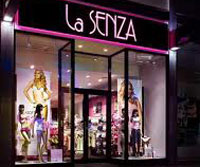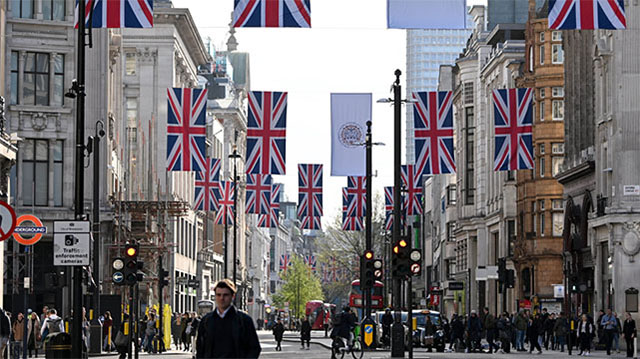She was a star with a great US heritage – if not quite Hollywood. But troubled lingerie business La Senza is now no more, after years of addiction to private equity and ill-judged makeovers finally took their toll. EG charts her rise and fall
The life of the starlet is never easy. A bright, sexy start is too often followed by addiction, some drastic makeovers, then misery, collapse and oblivion.
The life of La Senza UK – which died last month, aged 20 – largely fitted the pattern.
La Senza UK, 1994-2014, can trace its origins back to the Montreal suburb of Dorval in French-speaking Canada – home of the La Senza Corporation.
Its North American twin – in a stable of starlets owned by Ohio-based L Brands since 2006 – continues to thrive, as do dozens of half-sisters and franchise operations around the world. But in the UK the company always struggled.
La Senza arrived in Britain in 1994, fresh-faced and convinced that sexy lingerie was now mainstream. Post-feminist woman wasn’t afraid to admit she liked frills and a bit of lace. La Senza was an instant star.
Yet things quickly got complicated. The UK subsidiary of parent company Suzy Shier attempted to grow the business fast – too fast – and quickly lost control of its property portfolio.
By 1997 there were 46 La Senza outlets in the UK and more on the way, even though losses were mounting (accounting for about 10% of turnover). Expansion plans were scaled back – from 35 new stores in 1997 to a mere 28 – but the aim remained rapid mass-market growth. The company expected to have 170 stores by 2001.
It was not to be. Amid concerns about an unsustainable rent bill, the parent company pulled the plug in 1998. The business and a licence to trade was sold for barely the cost of a pair of tights (plus £1.13m for the rest of the shares) to Dragons’ Den star Theo Paphitis, in those days better known as the man who rescued stationery chain Ryman.
This was the first of La Senza’s celebrity encounters and it was a success. La Senza surfed the dotcom boom then the debt boom of the noughties. Successful people wanted luxury lingerie and La Senza ?provided something that struggling Marks & Spencer – still dominant in ?the under-apparel market – could not match.
In 2006, Paphitis sold the chain to private equity house Lion Capital and, according to Stephen Springham, senior analyst at Planet Retail, this is where La Senza’s problems began. In short, it was addicted to private equity.
“As soon as private equity is involved it is bad news. Private equity and retail are, generally, a toxic mix,” says Springham.
“It’s the same old story. A retailer that collapses once collapses again. Normally it happens serially and normally it is not the shop floor that’s the problem, but the management. La Senza is a classic case. No matter how many prepack administrations the retailer has, things simply get worse.”
To be fair to Lion Capital, the timing of the recession didn’t help. But observers say that over-expansion of the store portfolio was also to blame. By 2011, when La Senza plunged into administration, it had 146 stores. Administrator KPMG proposed to close 81 of them to make the chain more viable.
However, the UK lingerie sector had become more complicated (see below). For La Senza this was fatal because, like many starlets, the brand had not aged well. What was daring in 1994 was by 2011 so mainstream that the target customers’ mothers were wearing it. This was naturally a passion killer.
Kuwaiti franchise operator Alshaya took over a slimmed-down 60-store network in 2012. According to those close to the market, that should have solved La Senza’s problems – if those problems were property-related.
Sam Foyle, head of in-town retail at Savills, has been working to dispose of stores on behalf of PwC, the administrator appointed in June. He says the portfolio was in good shape.
“Property wasn’t part of the problem for La Senza. The portfolio was trimmed in 2011 to reflect the needs of a good, modern estate – it had good locations and good-quality premises, and the list of 55 stores suited today’s market,” he explains.
Foyle says if the stores had been the problem he would not have had such strong interest from other lingerie retailers, as well as from fashion fascias, jewellers and the ubiquitous phone shops.
Cutting back on property commitments was a wise move, says Springham. He agrees La Senza’s recent woes can be explained by problems outside the store portfolio.
As the starlet approached middle-age, La Senza began to think about cosmetic surgery. No surprise then that an expensive, and perhaps ill-judged, makeover of the brand ordered by the new Kuwaiti owner seems to have helped seal its fate. New product lines and fresh-look stores were proposed by Alshaya. Its aim was to propel slightly mumsy La Senza into a post-Fifty Shades of Grey world in which suspenders and micro-bras were no longer regarded as particularly daring. According to some sources, the makeover was priced at around £100m.
The last set of accounts filed for the year ending 31 December 2012 shows losses ballooning to £26m on a turnover of £43m, largely thanks to the store makeover programme. That kind of haemorrhage was never going to be sustainable.
Springham says: “Over-expansion, too fast and too quickly, was an issue. But mismanagement is also an issue. Look at HMV, which had similar problems but got back on its feet. La Senza didn‘t.”
So the end arrived. In June, Robert Moran, Mike Jervis and Stuart Maddison of PwC were appointed as joint administrators of Marnixheath Ltd. The North American operations of La Senza and throughout the rest of the world remain unaffected by the actions taken in the UK.
Last month, the remaining 55-store portfolio was liquidated in a series of sales and lettings. La Senza UK was, effectively, no more.
There are morals to be drawn from brief lives such as this. La Senza’s sad tale shows the dangers of growing up too fast and how quickly today’s sexy turns into tomorrow’s cosy.
But there is one bright spot, one ?thing to treasure in the life and death of La Senza. In the end, it wasn’t ?property that killed it. It was someone else’s fault.
Knickers in a twist – the UK lingerie market
Mintel estimates that the UK lingerie market is worth a little under £3bn a year and is fairly stable once its modest growth is matched against inflation. But it’s a tough market – as La Senza found – because British consumers have some profound and inflexible attitudes to their smalls.
Most consumers only buy to replace existing under-apparel, and when they do buy they tend to stick to whatever style or make they have had in the past. This is in stark contrast to the rest of the clothing market, which is driven by a desire for novelty.
The result is that a relatively small slice of the underwear market is up for grabs, and competition in the sector is fierce. Two names from La Senza’s past have claimed a big share: former owner Theo Paphitis’ Boux Avenue lingerie chain and Victoria’s Secrets, owned by La Senza’s licensor, L Brands.
Meanwhile, old war horses like Marks & Spencer have shown they can still fight. The Rosie for Autograph collection created by model Rosie Huntington-Whiteley and M&S has cut swathes through the underwear sector. House of Fraser has also upped its investment in lingerie ranges.
Planet Retail’s Stephen Springham says: “In a highly competitive market the mainstream average retailer will be exposed. The big, sexy names like Boux Avenue, and more stylised offers like Victoria’s Secrets, plus the dominance of Marks & Spencer – which still does well on underwear – and newcomers like Primark, mean it’s tough.”











